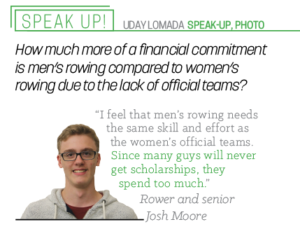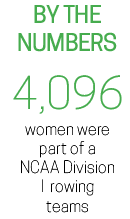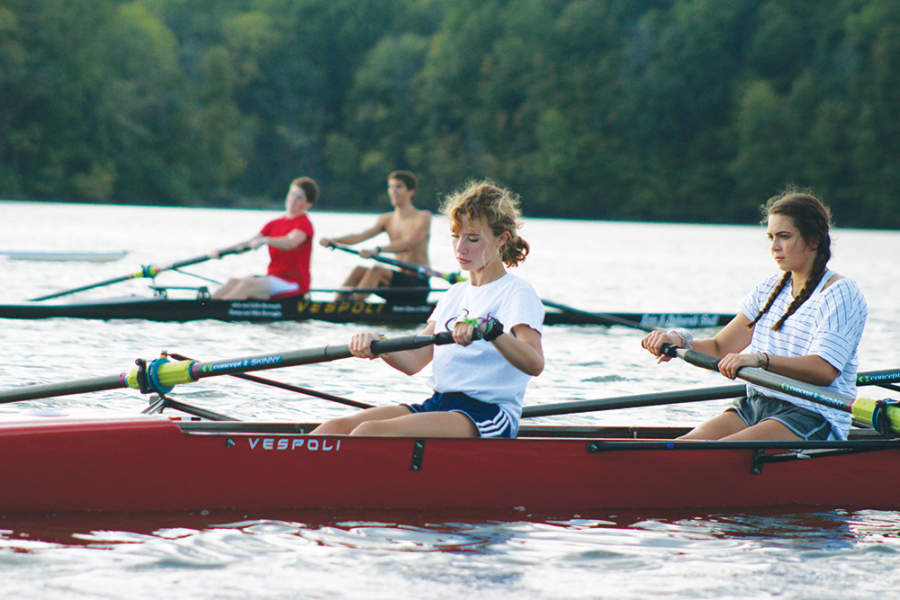Julia sweet, varsity rower and junior, is considering rowing in college; however, she said she is hesitant for a number of reasons.
“Rowing in college is a tough decision, because although it is so rewarding, college rowing is very rigorous. Right now, I could probably see myself walking on freshman year to meet people and then seeing what I think of it from there,” Sweet said.
Sweet is part of a growing number of athletes who have given recent rise to rowing’s popularity. As colleges add more sports, more athletic scholarships become available for those who are eligible. According to U.S. Rowing, 225 programs for men and women’s rowing exist nationwide in 2016, compared to 90 men’s programs and 98 women’s programs total in 1997.

ROWING Hard:
Members of the Indianapolis Rowing Center’s team (IRC) work to put a boat in the water before practice. The IRC team starts with land training before they get their boats out on the reservoir.
However, according to Rachael Agbonhese, varsity women’s Indianapolis Rowing Center (IRC) coach, while the number of programs and participants is growing, the number of scholarships is not. At the collegiate level, women’s rowing is a National Collegiate Athletic Association (NCAA) Division I sport, whereas for men, it’s only a club sport. Women’s rowing is an equivalency sport, so schools award partial scholarships in any proportion to meet the limit per school. For example, an NCAA Division I team can give out 40 half-scholarships and still meet the NCAA school limit of 20 scholarships. Generally speaking, however, the reason for less athletic scholarship money offered to rowers is attributed to the cost of the sport and that rowing isn’t a spectator sport. Also, according to Agbonhese, it’s a relatively expensive sport.
“Take basketball for example. It costs whatever amount to upkeep the gym, order jerseys and some basketballs. The revenue they generate in college basketball is in the millions upon millions nationwide,” Agbonhese said. “Rowing costs $15,000 to $20,000 for a boat and then when (the team) travels, they have to pay to transport those boats with a trailer. Then you have to rent a boathouse from someone with a large body of water.”
Other expenses include a power boat for coaches, gas and indoor mechanical rowing machines that cost in the thousands as well. On top of the large costs for rowing, few spectators come to watch competitions for fun unless they know the rowers, Agbonhese said. The cost leaves much less money for scholarships.

According to Agbonhese, women have more resources from schools to obtain scholarships because women’s rowing is a part of the NCAA. Andrew Purdie, executive director of the IRC, said he agreed and noted that equal amounts of men and women continue from IRC. He estimated that a handful of rowers each year from IRC go to row at varsity and club programs.
“Collegiate rowing is separated into varsity and club rowing. The varsity programs, primarily for women, are the programs that most actively recruit and the only ones that offer scholarships. Each year we have about two to three rowers who will be going to a college or university to row in a varsity program,” Purdie said. “A club program is just like any other collegiate club sport which gets minimal funding from the school and is therefore funded by the rowers themselves. I would say we have between five to six rowers each year that will go on to participate in rowing as a club sport collegiately.”
As a two-year rower herself, Sweet said she has noticed quite a few of her team members commit to rowing in college each year.
“I do notice a lot of people at IRC looking into different scholarship opportunities,” she said. “One girl on the team this year got a great scholarship from George Washington University. It is a very personal choice if you want to commit to rowing in college in exchange for that money.”
Since rowing is a team sport, colleges assess recruits based on how the team the recruit is on performs and how an athlete would acclimate to the college team. Smaller teams make it easier for colleges to watch their recruit or recruits, according to Agbonhese.
Purdie said, “Most college coaches are willing to assume that they will have to work with the athletes, to varying degrees, to make them part of the team. Rowing is a somewhat unique sport in that way because there are multiple levels of being part of the team. There is the team as a whole, and there is being part of an eight-or-four-person boat.”
Agbonhese, who was a rower in college at the University of California, Berkeley and is currently working with a junior rower through the recruiting process, said it can be tricky to enter into negotiations with colleges but said it’s rewarding after putting in the work it takes to get noticed.
said it’s rewarding after putting in the work it takes to get noticed.
“It’s hard to know how much you are worth, in a sense. Overall, it was very fun though to have my choice of Ivy League schools that my grades would never get me into,” Agbonhese said. “It’s just about communication and showing interest in a school even if you aren’t totally sold. They want people who want to be there.”
Sweet said recognition for the hard work and dedication that rowers put into their sport would be appreciated at Carmel, and other schools as well, by the rowing community as a whole.
“I think that Carmel should make its own rowing club and also have that count as a (physical education) credit. Because rowing is such hard work, it would be nice to have recognition of the sport from the administration,” Sweet said.
According to Agbonhese, rowing with a team can be a great alternative for people who are looking to work hard and try their hand at something new.
“I think more people should try rowing, especially those students who love sports and want a scholarship but maybe aren’t skilled enough to do that in their sport,” she said. “Or if they get burned out on their sport, most people who like to work hard love rowing. The Indy program has grown and has some wonderful, supportive coaches who are very invested in the rowers. It’s a great community with some amazing, hard working, confident people.”































![What happened to theater etiquette? [opinion]](https://hilite.org/wp-content/uploads/2025/04/Entertainment-Perspective-Cover-1200x471.jpg)














































![Review: “The Immortal Soul Salvage Yard:” A criminally underrated poetry collection [MUSE]](https://hilite.org/wp-content/uploads/2025/03/71cju6TvqmL._AC_UF10001000_QL80_.jpg)
![Review: "Dog Man" is Unapologetically Chaotic [MUSE]](https://hilite.org/wp-content/uploads/2025/03/dogman-1200x700.jpg)
![Review: "Ne Zha 2": The WeChat family reunion I didn’t know I needed [MUSE]](https://hilite.org/wp-content/uploads/2025/03/unnamed-4.png)
![Review in Print: Maripaz Villar brings a delightfully unique style to the world of WEBTOON [MUSE]](https://hilite.org/wp-content/uploads/2023/12/maripazcover-1200x960.jpg)
![Review: “The Sword of Kaigen” is a masterpiece [MUSE]](https://hilite.org/wp-content/uploads/2023/11/Screenshot-2023-11-26-201051.png)
![Review: Gateron Oil Kings, great linear switches, okay price [MUSE]](https://hilite.org/wp-content/uploads/2023/11/Screenshot-2023-11-26-200553.png)
![Review: “A Haunting in Venice” is a significant improvement from other Agatha Christie adaptations [MUSE]](https://hilite.org/wp-content/uploads/2023/11/e7ee2938a6d422669771bce6d8088521.jpg)
![Review: A Thanksgiving story from elementary school, still just as interesting [MUSE]](https://hilite.org/wp-content/uploads/2023/11/Screenshot-2023-11-26-195514-987x1200.png)
![Review: "When I Fly Towards You", cute, uplifting youth drama [MUSE]](https://hilite.org/wp-content/uploads/2023/09/When-I-Fly-Towards-You-Chinese-drama.png)
![Postcards from Muse: Hawaii Travel Diary [MUSE]](https://hilite.org/wp-content/uploads/2023/09/My-project-1-1200x1200.jpg)
![Review: "Ladybug & Cat Noir: The Movie," departure from original show [MUSE]](https://hilite.org/wp-content/uploads/2023/09/Ladybug__Cat_Noir_-_The_Movie_poster.jpg)
![Review in Print: "Hidden Love" is the cute, uplifting drama everyone needs [MUSE]](https://hilite.org/wp-content/uploads/2023/09/hiddenlovecover-e1693597208225-1030x1200.png)
![Review in Print: "Heartstopper" is the heartwarming queer romance we all need [MUSE]](https://hilite.org/wp-content/uploads/2023/08/museheartstoppercover-1200x654.png)



